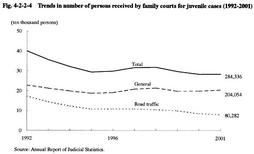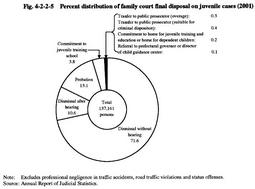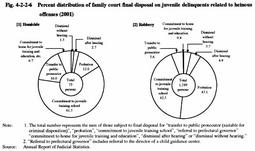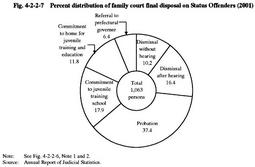| Previous Next Index Image Index Year Selection | |
|
|
2 Juvenile hearing Fig. 4-2-2-4 shows the trends of the number of persons received by family courts for juvenile cases for the past 10 years. Trends are shown separately for general cases and road traffic cases (juvenile cases related to road traffic violations) (see Appendix 4-9 ).
The number received in 2001 showed a slight decline for road traffic cases. However, the total number for general cases was 284,336 Persons, showing an increase by 947 persons in total (0.3%) from the previous year. Fig. 4-2-2-5 shows the details of the final disposal of family courts in 2001 for juvenile cases other than those involving professional negligence in traffic accidents, road traffic violations and status offenses. Fig. 4-2-2-4 Trends in number of persons received by family courts for juvenile cases (1992-2001) Fig. 4-2-2-5 Percent distribution of family court final disposal on juvenile cases (2001) Dismissal without hearing had the largest share (over 70%), followed by dismissal after hearing (over 10%), the protective measures such as probation, commitment to juvenile training school, etc. (16.9%).Fig. 4-2-2-6 shows the details of family court final disposal on juvenile delinquents related to homicide, and robbery in 2001. Fig. 4-2-2-6 Percent distribution of family court final disposal on juvenile delinquents related to heinous offenses (2001) As for homicide, compared with the details of the final disposal of juvenile cases excluding professional negligence in traffic accidents, road traffic violations and status offenses, the percent distribution of both transfer to public prosecutors and commitment to juvenile training schools was much higher.As for robbery, the percent distribution of probation and commitment to juvenile training schools was almost 80%. Compared with the details of the final disposal of juvenile cases excluding professional negligence in traffic accidents, road traffic violations and status offenses, the percent distribution of transfer to public prosecutors, commitment to juvenile training school or probation was higher. In addition, the Law for Partial Amendment to the Juvenile Law, etc. has been enforced since April, 2001. In 2001, examining the percentage of transfer to public prosecutor concerning details of the final disposal of juvenile cases relating to homicide, and robbery, the percentage rose 2.0 points (16.0%) from the previous year for homicide, and rose 3.2 points (5.6%) for robbery. Fig. 4-2-2-7 shows details of family court final disposal on status offenders in 2001. Compared with details of the final disposal of juvenile cases excluding professional negligence in traffic accidents, road traffic violations and status offenses, the percent distribution of both probation and commitment to juvenile training school was higher in 2001. Fig. 4-2-2-7 Percent distribution of family court final disposal on Status Offenders (2001) |



